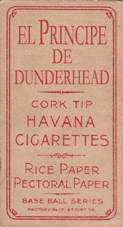Deadball Era Postcards, Snapshots into the past
5 posters
Page 1 of 1
 Deadball Era Postcards, Snapshots into the past
Deadball Era Postcards, Snapshots into the past
I don't have many but really like Deadball Era Postcards of Players in action Poses.
It's a true Snapshot of the past. I will be trying to add more in the future.
Would like to see some from members collections.
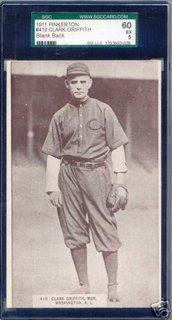

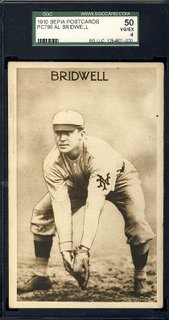
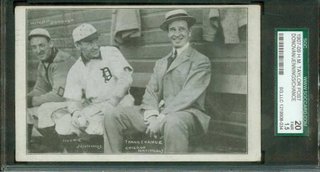
It's a true Snapshot of the past. I will be trying to add more in the future.
Would like to see some from members collections.




 Re: Deadball Era Postcards, Snapshots into the past
Re: Deadball Era Postcards, Snapshots into the past
I like the pictures on postcards a lot. As you said, they provide a more accurate look into the game than the images you seem on most standard cards.
Jay
Jay
 Re: Deadball Era Postcards, Snapshots into the past
Re: Deadball Era Postcards, Snapshots into the past
Here's one. It says "Brown", but I always thought is was a Sepia Postcard... 
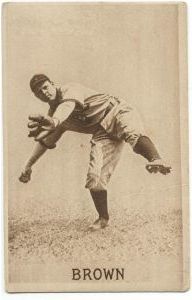


glenv- FC NCAA Bracket Champ

- Posts : 178
Trader Points :



 Re: Deadball Era Postcards, Snapshots into the past
Re: Deadball Era Postcards, Snapshots into the past
The 1921 Exhibit set is full of in action poses, here are a few of my favorites-
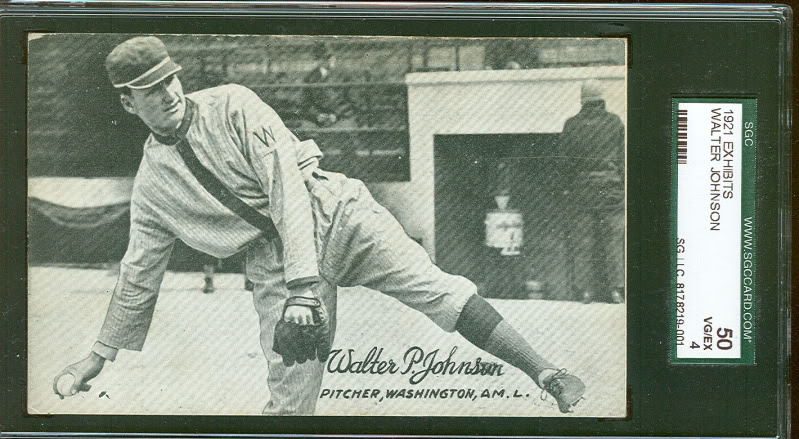
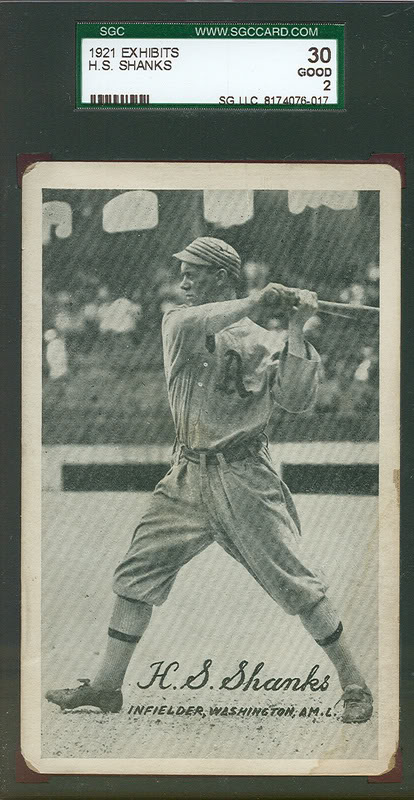


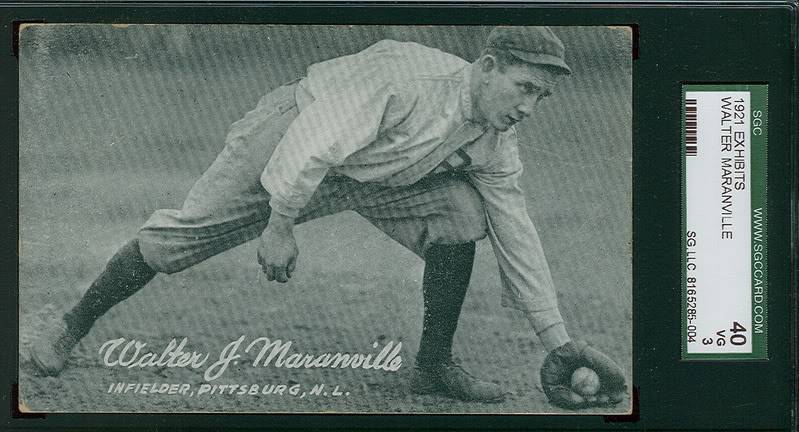
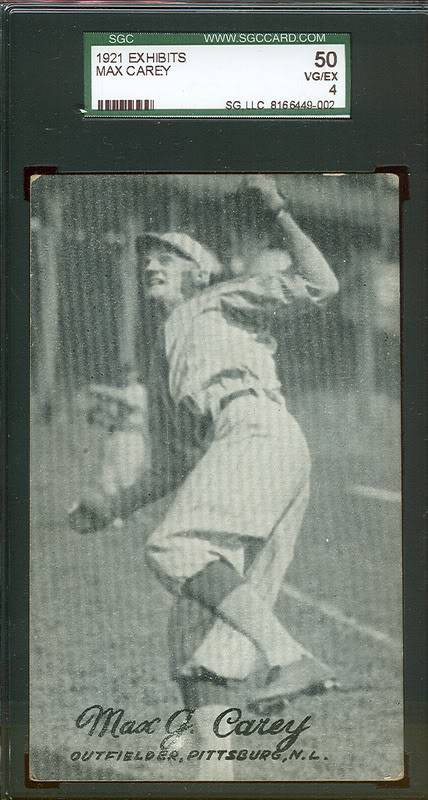






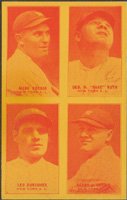
smtjoy- All Star

- Posts : 134
Trader Points :



 Re: Deadball Era Postcards, Snapshots into the past
Re: Deadball Era Postcards, Snapshots into the past
Always thought this rppc was special. Hopefully you don't mind the long write up below, but it truly is a great read.
Historic Baseball Game
October 24, 1913
In 1913, Chicago White Sox owner Charles Comisky initiated a "WorldTour" of baseball to help promote the spread of baseball to other countries. Original plans called for it to be a series of games betweenthe White Sox and New York Giants, but because some Giant and White Sox players chose not to participate, players from other teams filled out the rosters. Following the World Series, the teams began their
tour in Cincinnati. The Giants had won the National League pennant and had just lost the World Series, 4 games to 1, to the Philadelphia
Athletics. Towns wanting to host the touring teams were required to put up a $1,000 guarantee. A group of Blue Rapids businessmen acted quickly to sell shares of stock and raise the needed money. After securing the game, a large effort was made to publicize it and sell tickets. Dozens of area banks became ticket outlets, and posters were distributed for up to 100 miles. Blue Rapids was the seventh game on the tour. It was the only Kansas town included and the smallest town among the 49 playing sites. A special train carrying the World Tour entourage arrived at the depot at 7:00 am on October 24, after the teams played a the previous day in Sioux City, Iowa. At noon, the schools and most businesses closed. The town folk and out of town visitors gathered for a parade of players and bands around the town square, and they marched down to the ball park, where the game began at 2:30. More than 3,000 people attended, paying $1.00 for advanced tickets and $1.50 at the gate. These were considered "major league" prices. The baseball teams received $1,800, and the locals cleared nearly $500 profit. The White Sox won the game 8-5. After leaving Blue Rapids, the players traveled on through the Southwest and up the Pacific coast to Vancouver, British Columbia, where they sailed to Japan. They continued their series along the Pacific rim, to Ceylon and India, and through the Suez Canal to Egypt. They wound up with several games in Europe, the last and most exciting being played in front of King George V in England. The teams arrived back in New York on March 6, 1914.
The Players
Several baseball figures in Blue Rapids that day went on to attain sports immortality. Larry Doyle,Giants second baseman, was the National League's Most Valuable Player in 1912 and considered one of the best defensive players at his position in baseball history. Sam Crawford,
a Detroit Tiger who played for Chicago, was inducted into the Baseball Hall of Fame as an outfielder and played alongside Ty Cobb. John McGraw was the manager of the Giants. McGraw, nicknamed the "Little Napoleon", was known as a fiery competitor as a player, and a manager and was inducted into the Hall of Fame in its second class in 1937. Umpire William Klem set the standard for umpires in the early days. Klem
worked strictly behind the plate for 16 years and was known for his command of the strike zone. Klem is one of 3 umpires in the Baseball
Hall of Fame. He originated the use of hand signals to illustrate his calls. Christy Mathewson was one of the original five inductees into the Hall of Fame. Mathewson was known for his intelligence and integrity as a gentleman, besides being one of the best pitchers in baseball history. Jim Thorpe, Giants outfielder, was a very good baseball player but received more acclaim in other endeavors. Thorpe won gold medals in the 1912 Olympics in the pentathlon and decathlon. He also was a collegiate All American and Hall of Fame player in football. Thorpe went on to become first president of what later became the National Football League. He has been called the world's greatest athlete. At the time of his ball game
in Blue Rapids, he was on his honeymoon. A player who received notoriety was Chicago shortstop Buck Weaver. Weaver was among the players suspended following the "fixing" of the 1919 World Series. Although Weaver was not directly involved, he had knowledge of the plot and was banned from baseball for life in 1920.
Shown is the parade of NY Giant & Chicago Whitesox players walking behind a marching band who look to be playing their hearts out as they
make their way down town square on their way to the ball park that day on Oct 24th 1913 in Blue Rapids Kansas as mentioned in the article
above. Although probably very tough for you to make out in the scan, the 2nd ball player in, far right does look to be Thorpe. The player to
the left of the trumpet player has his catcher's gear under his left arm with glove on hand. What I find interesting about the text on the back is that the person who wrote this was actually at the parade & game that day and mentions having the chance to shake the hands of such players as Jim Thorpe, John Mcgraw, and others. It's amazing how quickly someone produced this piece. It's postmarked only two short days after this game was played on that glorious day.
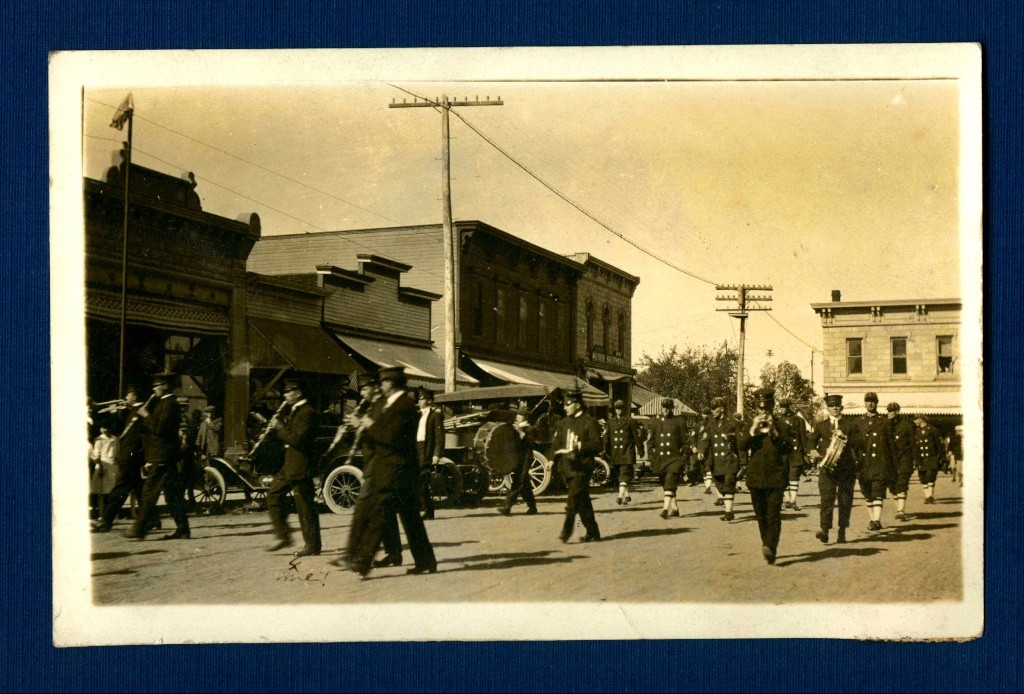
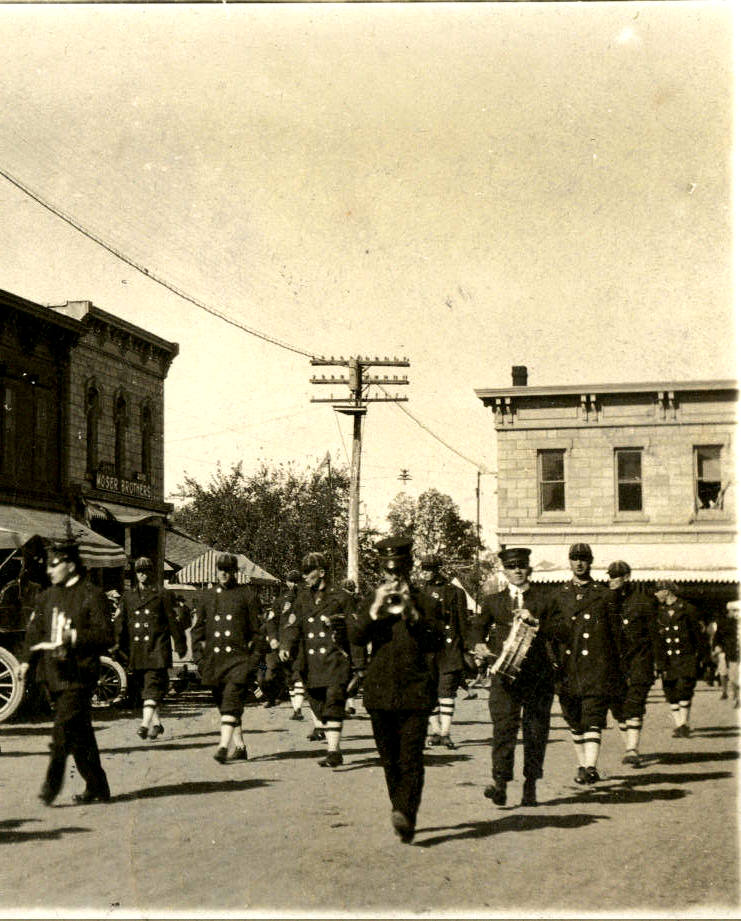
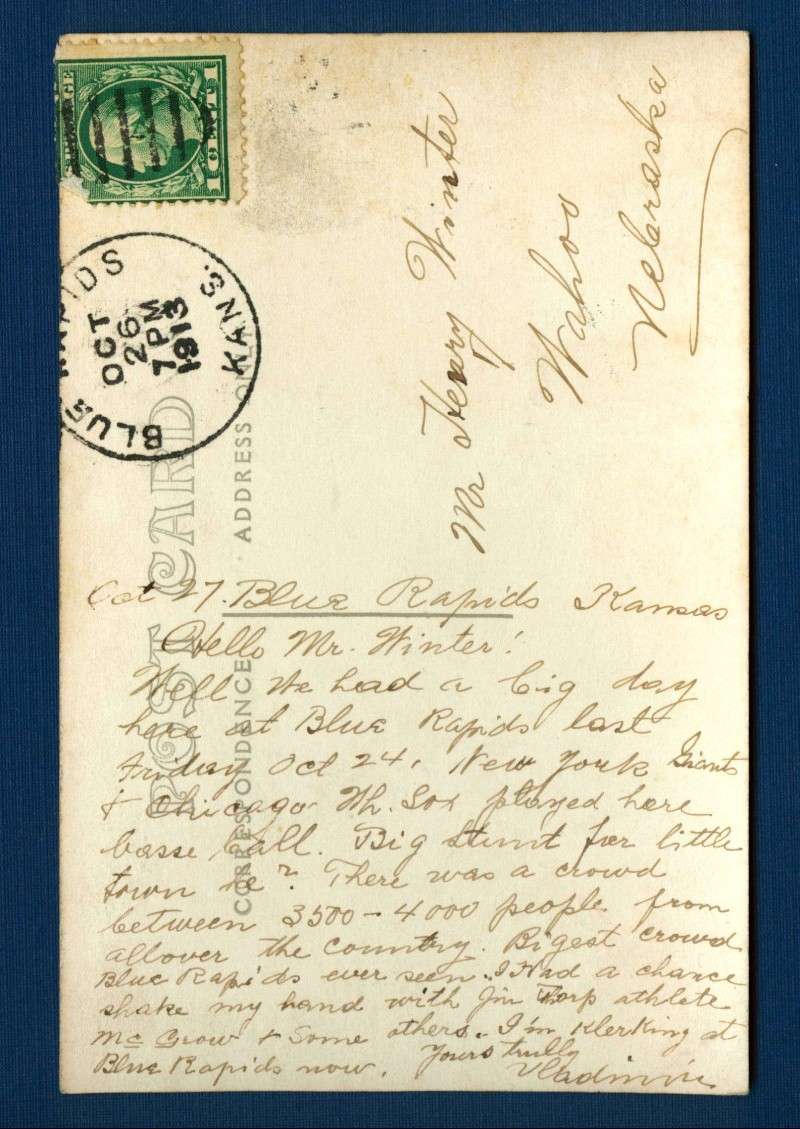
Historic Baseball Game
October 24, 1913
In 1913, Chicago White Sox owner Charles Comisky initiated a "WorldTour" of baseball to help promote the spread of baseball to other countries. Original plans called for it to be a series of games betweenthe White Sox and New York Giants, but because some Giant and White Sox players chose not to participate, players from other teams filled out the rosters. Following the World Series, the teams began their
tour in Cincinnati. The Giants had won the National League pennant and had just lost the World Series, 4 games to 1, to the Philadelphia
Athletics. Towns wanting to host the touring teams were required to put up a $1,000 guarantee. A group of Blue Rapids businessmen acted quickly to sell shares of stock and raise the needed money. After securing the game, a large effort was made to publicize it and sell tickets. Dozens of area banks became ticket outlets, and posters were distributed for up to 100 miles. Blue Rapids was the seventh game on the tour. It was the only Kansas town included and the smallest town among the 49 playing sites. A special train carrying the World Tour entourage arrived at the depot at 7:00 am on October 24, after the teams played a the previous day in Sioux City, Iowa. At noon, the schools and most businesses closed. The town folk and out of town visitors gathered for a parade of players and bands around the town square, and they marched down to the ball park, where the game began at 2:30. More than 3,000 people attended, paying $1.00 for advanced tickets and $1.50 at the gate. These were considered "major league" prices. The baseball teams received $1,800, and the locals cleared nearly $500 profit. The White Sox won the game 8-5. After leaving Blue Rapids, the players traveled on through the Southwest and up the Pacific coast to Vancouver, British Columbia, where they sailed to Japan. They continued their series along the Pacific rim, to Ceylon and India, and through the Suez Canal to Egypt. They wound up with several games in Europe, the last and most exciting being played in front of King George V in England. The teams arrived back in New York on March 6, 1914.
The Players
Several baseball figures in Blue Rapids that day went on to attain sports immortality. Larry Doyle,Giants second baseman, was the National League's Most Valuable Player in 1912 and considered one of the best defensive players at his position in baseball history. Sam Crawford,
a Detroit Tiger who played for Chicago, was inducted into the Baseball Hall of Fame as an outfielder and played alongside Ty Cobb. John McGraw was the manager of the Giants. McGraw, nicknamed the "Little Napoleon", was known as a fiery competitor as a player, and a manager and was inducted into the Hall of Fame in its second class in 1937. Umpire William Klem set the standard for umpires in the early days. Klem
worked strictly behind the plate for 16 years and was known for his command of the strike zone. Klem is one of 3 umpires in the Baseball
Hall of Fame. He originated the use of hand signals to illustrate his calls. Christy Mathewson was one of the original five inductees into the Hall of Fame. Mathewson was known for his intelligence and integrity as a gentleman, besides being one of the best pitchers in baseball history. Jim Thorpe, Giants outfielder, was a very good baseball player but received more acclaim in other endeavors. Thorpe won gold medals in the 1912 Olympics in the pentathlon and decathlon. He also was a collegiate All American and Hall of Fame player in football. Thorpe went on to become first president of what later became the National Football League. He has been called the world's greatest athlete. At the time of his ball game
in Blue Rapids, he was on his honeymoon. A player who received notoriety was Chicago shortstop Buck Weaver. Weaver was among the players suspended following the "fixing" of the 1919 World Series. Although Weaver was not directly involved, he had knowledge of the plot and was banned from baseball for life in 1920.
Shown is the parade of NY Giant & Chicago Whitesox players walking behind a marching band who look to be playing their hearts out as they
make their way down town square on their way to the ball park that day on Oct 24th 1913 in Blue Rapids Kansas as mentioned in the article
above. Although probably very tough for you to make out in the scan, the 2nd ball player in, far right does look to be Thorpe. The player to
the left of the trumpet player has his catcher's gear under his left arm with glove on hand. What I find interesting about the text on the back is that the person who wrote this was actually at the parade & game that day and mentions having the chance to shake the hands of such players as Jim Thorpe, John Mcgraw, and others. It's amazing how quickly someone produced this piece. It's postmarked only two short days after this game was played on that glorious day.



 Re: Deadball Era Postcards, Snapshots into the past
Re: Deadball Era Postcards, Snapshots into the past
Love the write up and the note on the back of the postcard. Got to shake the hand of Jim Thorpe. I'd say that would be a major highlight.
Jay
Jay
 Re: Deadball Era Postcards, Snapshots into the past
Re: Deadball Era Postcards, Snapshots into the past
Great story and Postcard, Tony
Thats what it's all about.
A big day for a small town in Kansas.
Thats what it's all about.
A big day for a small town in Kansas.
 Similar topics
Similar topics» THE DRAFT SO FAR: Rounds 1-24
» Bregstone postcards and more
» Past Champions
» Ghost of Baseball Past
» A Gallery of Past Full Count Header Images
» Bregstone postcards and more
» Past Champions
» Ghost of Baseball Past
» A Gallery of Past Full Count Header Images
Page 1 of 1
Permissions in this forum:
You cannot reply to topics in this forum|
|
|

